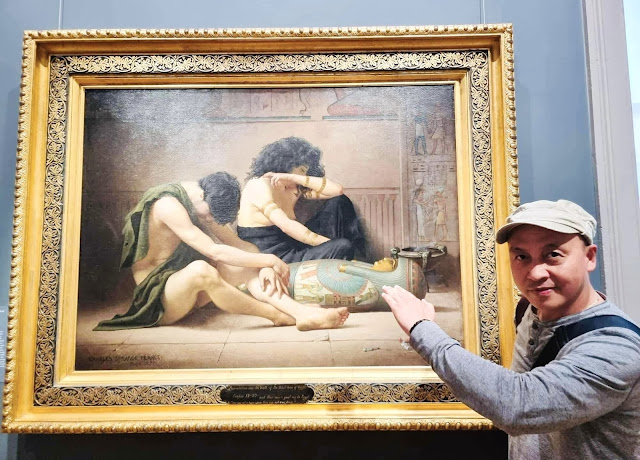“The aim of art is to represent not the outward appearance of things, but their inward significance.”
—Aristotle
By Alex P. Vidal
IN my visit at the Smithsonian American Art Museum in Washington, D.C. recently, I stumbled into one of the finest works of art, Lamentations over the Death of the First-Born of Egypt, by Charles Sprague Pearce, one of the most inquisitive and ambitious of the expatriate American painters in Europe in his day.
The painting is made of oil in canvas dated 1877.
At various times experimenting with realism, neo-grec historicism, Orientalism (both modern and biblical), plein-air naturalism, Japonism, impressionism, symbolism, and pointillism, Pearce based this work on a passage from the biblical Book of Exodus describing the tenth plague of Egypt, in which God declared his intention to kill every first-born Egyptian child unless Pharaoh freed the Israelites.
He instructed Moses to tell the Jews to mark their doors, so that their children would be spared.
Pearce paints the aftermath of this vengeful slaughter, as these distraught parents prepare their son for burial. Shawabtis—clay figurines traditionally buried with the dead to accompany the body to the afterlife—litter the floor.
In the Victorian era, when infant mortality was still prevalent and many parents endured the loss of a child, Pearce’s Old Testament subject aroused all-too-modern feelings of grief.
-o0o-
Pearce’s blend of the exotic and the popular led him to become a sought after artist in both Europe and America, perpetuating the interest in Orientalist aesthetics, among many other preoccupations, as well as the search for newer styles and iconography strongly influenced by what was shown at the public Salon exhibitions.
During the mid-nineteenth century, before America had truly established its claim to artistic originality, American artists were seduced by the fascinating Parisian art scene.
During the latter half of the nineteenth century an important group of American artists congregated in France, among them Mary Cassatt, James Abbot MacNeill Whistler—though only temporarily- and Daniel Ridgway Knight, among many others.
Another American artist, albeit one who has not been given sufficient attention, is Charles Sprague Pearce, whose presence in Paris and later Auvers-sur-Oise was important for the propagation and appreciation of American artwork, even though he continued to be strongly influenced by the predominant European artistic styles of the period.
According to Rehs Galleries, Inc., Pearce was born on October 13, 1851 to a wealthy Bostonian family. From an early age he was immersed in a setting which nurtured his appreciation of the arts—his parents played the piano and the violin, and his father was a dealer of Chinese porcelains.
Pearce’s father must have been keenly aware of the increasing fervor with which collectors began to seek these exotic works which also suggests his understanding of the artistic trends of the period.
-o0o-
From the Smithsonian American Art Museum, I proceeded to Renwick Gallery of the Smithsonian American Art Museum located across the White House.
A huge new exhibition that celebrates the diversity of American craft is now on view at the Renwick Gallery, which celebrates its 50th anniversary.
The massive display marks Smithsonian museum’s anniversary and presents an impressive spread of 171 works that weave through each room of the two-storied museum.
Washingtonian reports that This Present Moment: Crafting a Better World began as an acquisition campaign that focused on adding artworks made by a diverse and representative group of American artists, working across different media, to the museum’s permanent collection.
The 50th anniversary campaign added more than 200 pieces to Smithsonian’s permanent craft collection, including many by Black, Latinx, Asian American, and indigenous artists. LGBTQ+ and women artists are also among the expansive acquisitions.
More than a hundred of the artworks in This Present Moment: Crafting a Better World are being shown for the very first time, including works like Bisa Butler’s vibrant quilt that depicts the Black World War I regiment the Harlem Hellfighters and Sonya Clark’s humongous reimagined flag, Monumental (2019).
One of my most favorites on display is the “Don’t Tread On Me, God Damn, Let’s Go!”–Harlem Hellfighters monumental quilt by by Bisa Butler, who brings to life the history and emotions of nine members of the 369th Infantry Regiment known as the Harlem Hellfighters, a segregated unit of the American Expeditionary Force in World War II.
(The author, who is now based in New York City, used to be the editor of two local dailies in Iloilo.—Ed)



No comments:
Post a Comment